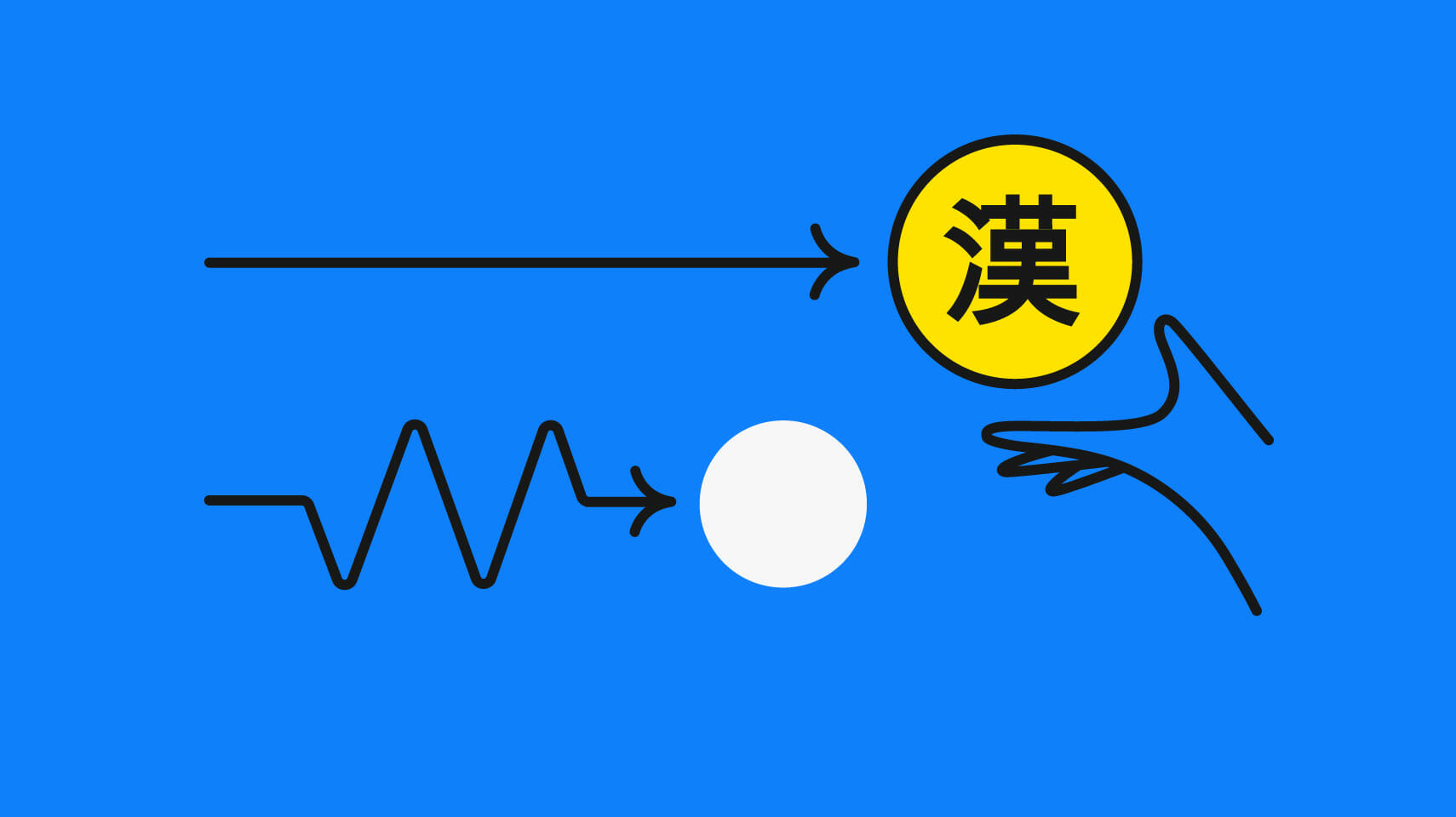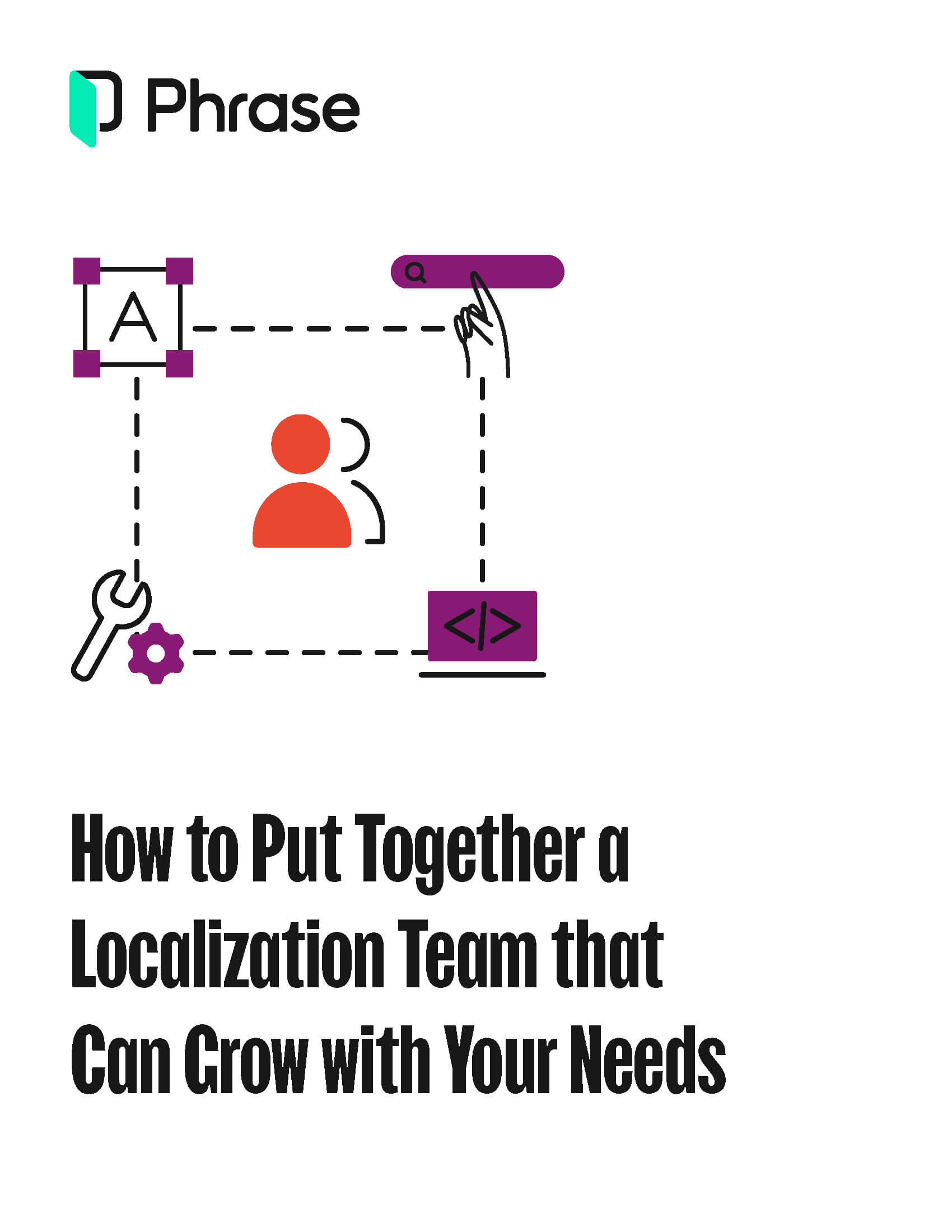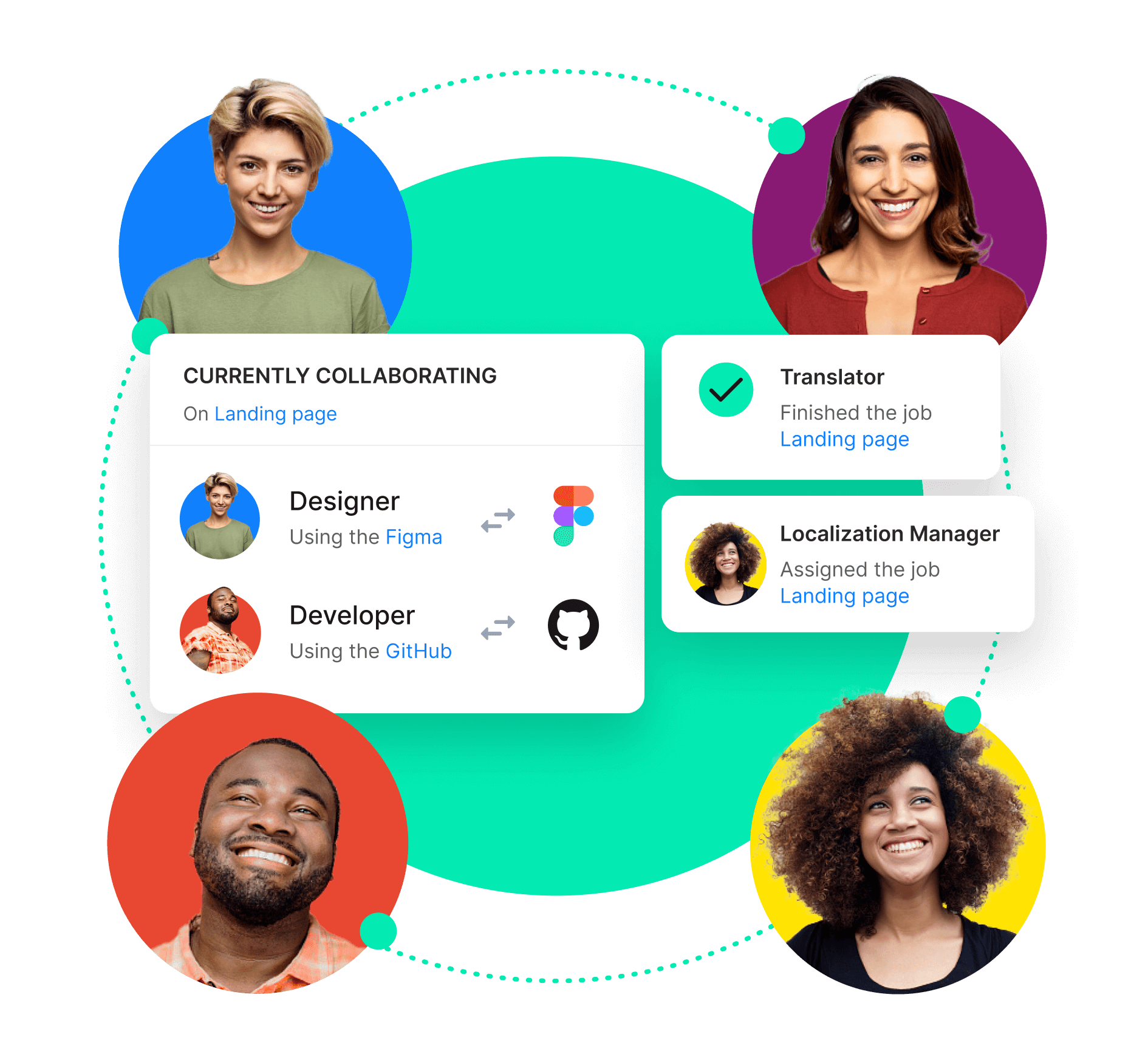Localization strategy
From Good to Great: Building a Localization Team That Drives Success

Reached the point where your brand or product needs to connect with audiences across markets and in different languages? Now is the time to build a strong localization team to ensure that your localization strategy is carried out with reliably high levels of quality and efficiency.
With localization requiring a variety of specialist skills, it’s rare to find people who’re proficient in more than 1 or 2 of them. It can also involve fluctuating and increasing volumes of work as well as pressurized timeframes for completing projects.
So how can you go about building your localization team? What roles should it unify—now and in the future—and how will you structure it? How can you get buy-in for your localization team from key decision-makers? Keep reading to learn best practices.
A decentralized team can create challenges
First things first, let’s look at how your localization team can fit within your organization. Should you build one centralized team or split your resources across territories and functions?
Often, a company’s approach to localization evolves in a decentralized manner, especially if there is no strategic plan to guide its development. Localization may be initiated by the marketing or product team, for example, and they develop processes and approaches that work for them.
Still, what about when the legal or HR teams need to localize materials, and they have completely different priorities and needs? Alternatively, localization efforts may begin in disparate languages or regions—with each using separate tools or systems.
In both decentralized scenarios, you might be missing serious opportunities for efficiency, consistently high-quality outputs, and easy scalability.
Centralized localization brings control
Taking a centralized approach to localization and building a dedicated localization team may seem daunting at first sight, especially if some of your localization tools are already entrenched, but it tends to offer high rewards.
If you have global aspirations, localization should, ultimately, touch every part of your business. It will become an ecosystem involving a wide range of stakeholders, tools, systems, processes, and resources. Having a central localization team will enable you to set a solid foundation for localization, so you can keep control of it as it grows, and more people, languages, channels, and resources become involved.
Advocates for globalization
What if you’re struggling to get buy-in for creating a dedicated localization team? Take time to emphasize to stakeholders and decision makers that localization plays a key strategic role in your organization’s international success. Having a strong team will ensure your localization is carried out with reliably high levels of quality and efficiency.
At this strategic level, your localization team’s key responsibilities will involve:
- Ensuring the localization technology used serves the whole organization globally.
- Setting a consistent approach for every language and project in established localization workflows.
- Centralizing and making the best use of localization assets, such as translation memory.
- Raising awareness of the importance of localization across your organization as part of the global business plan.
Which team model should you adopt?
Now let’s look at how you could structure your localization team. The most common models are:
- In-house as part of the marketing, content, or product team.
- In-house as a standalone department.
- Outsourced through a partnership with a translation consultancy.
There are reasons and benefits for each approach, so consider what would work best for you given your resources, priorities, and strategic plans.
What roles will be in your localization team?
If you decide to set up an in-house team, one of your first challenges might be working out which roles you need. When you’re doing this, it’s important to not only consider the roles you need now, but also the roles you’ll need as you scale your localization efforts. By establishing a formal team structure with the right balance of roles from the beginning, you’ll be able to maximize efficiency, and achieve consistent quality. And you’ll be well placed to scale easily when you need to.
Your localization team should ideally have the following capabilities or divisions:
Top-level management: Guiding and overseeing your localization program and ensuring all processes stay on track in terms of efficiency, quality, and strategic goals.
Roles within this division can include:
- Program director
- Program manager
- Localization manager
- Product manager
Production: Taking care of the day-to-day work related to localization projects.
Roles within this division can include:
- Translators
- Content creators (e.g., copywriter, technical writer, etc.)
- Software developer or localization engineer
- Project manager
- Workflow manager
Resource management: Sourcing, managing, and supporting the people and resources involved in production.
Roles within this division can include:
- Resource manager
- Vendor manager
- Technology manager
Quality management: Ensuring your localization projects are of consistently high quality.
Roles within this division can include:
- Quality manager
- Localization tester
Specialist skills
You’ll probably find that some of the roles you need for your localization team can be filled by people who’re already part of your organization. Try not to make the mistake, however, of assuming that people can do more than their core role.
For example, a software engineer is unlikely to have the skills to localize software, and many translators won’t either. For this kind of project, you may need specialist freelance support if it’s not an ongoing requirement.

Free download
How to choose the right people for your localization team
Discover the secrets to putting together the right team members to take your localization program to new heights.
Manage your budget wisely
If you’re facing budget constraints, bear in mind that cheap often isn’t best when it comes to the people, technology, and suppliers you appoint. It can be better to localize fewer items, or work with fewer languages, and produce high-quality work than try to squeeze too much out of your budget and let quality slide.
Another key point to bear in mind is that localization involves many different stakeholders, including people who commission and approve localization projects. Many of them won’t be within your localization team, but almost all can have an impact on your efficiency and costs, for example, by causing delays or repetition. Therefore, it’s important to factor that in as part of your approach to stakeholder management.
People supported by localization technology
To streamline your localization efforts, as well as scale them in the long run, you’ll also need a robust support infrastructure. This could include processes and support staff, as well as technology such as translation management software, machine translation, a translation memory database, term bases, etc.
Human effort is always the most expensive aspect of localization, so any manual tasks you can automate, without affecting quality, should be considered for automation. This will help to avoid human error and leave your team free to focus on what they’re best at, while also maximizing your investment in localization.
Now that you’re all familiar with the nitty-gritty of how to put together a strong and scalable localization team, it’s time to turn to what a strong localization team should be able to do to support the globalization efforts of your organization in the long run.
Keep human error to a minimum
Multiple customer requests, documents, mock-ups, prototypes, and screenshots… When you have a widely diverse and geographically dispersed team working in different time zones, the room for human error can be quite considerable—and costly. A localization team just starting out may not have the process well-oiled yet, but that doesn’t mean you can’t achieve great results or give your project to a rookie team.
You need to make sure that your localization team has filters in place for keeping human error to a minimum. These apply across the board of specialties: from your original content writers, translators, and proofreaders, to your developers and coders. One error in coding can leave your product looking broken. One lapse mistake while testing can cause compatibility issues. Not having enough pace in website design can lead to longer languages breaking the parameters.
It stands to reason: We’re humans, not machines. Translating volumes of texts from one language into several different ones or taking care of coding, images, and design simultaneously can quickly take its toll with its wide margin for human error. If you ever hear the words “spreadsheet” and “email threads” bandied around, get your localization team up to date and let them know why spreadsheets don’t work for localization. Using modern, cloud-based software for localization management that can completely automate the localization process is the most reliable way of keeping human error to a minimum.
When your localization team relies on translation management software, many repetitive processes are removed and manual work becomes a thing of the past. This isn’t only great news for your bleary-eyed translators whose fingers are going numb. It’s great news for your end results as well.
Built-in automation capabilities will help your localization team integrate new orders via an API. They can tag and update keys, recall important data, and import and export locale files. The built-in translation memory allows for all content to be stored and reused so your localization team can look up older versions with ease. They will also be spared from repeatedly writing out the same hard-to-use terms, thanks to a glossary with terms and terminology explained.
Collaborate easily
There’s no point in having the leading marketers in your chosen country, the expert advice of a legal team, and native translators specialized in your field if they can’t all work together. If you aren’t fortunate enough to create some utopian-style theme park of a working facility—like Google—with everyone together on one campus, you have to face reality.
Your localization team will most likely be dispersed. They may be working from small offices, or down to a single translator or coder working from home. If they can’t effectively collaborate and communicate, your project is going to get nowhere fast. So, don’t overlook this key element to ensuring the success of your localization team.
Imagine the worst-case scenario of your team being unable to collaborate effectively in localization:
- All geographically dispersed localization team members are being emailed spreadsheets left and right.
- Developers are creating and dispatching loads of isolated strings.
- Translators have no context and are pretty much working on gut feeling, without knowing if they’re translating a call to action (CTA), a subheading, or simply a text passage.
- Developers have no idea what to do with the translated texts as they receive them.
- When anyone has a question, it gets emailed to a project manager who’s not on shift. They then send it to the person in question, another day is lost and your email threads—having a snowball effect.
A translation management system can help you gather all your team in one place—the same place you keep all the files and data related to your project. By fostering real-time collaboration on a single platform, you can ensure a seamless, accurate, and on-time translation and localization workflow in the long run.
Translate directly onto the website
Imagine the time and hassle you could save your localization team if your translators could type directly onto the website that needs to be localized. No more receiving documents or strings with no context. No more need to guess where the words need to go or the maximum character count.
The whole team can see the words going up as translators proceed with translation and where each word will “live” in the user interface (UI). Your project is greatly sped up and the accuracy increases as well. Your team members can upload screenshots, tag other people involved, ask questions when in doubt, and see their work taking shape exactly how the end result will look. No more teaching complex coding to a specialist in Urdu translations, or the inner workings of a hard-to-grasp system.
You can also offer people with limited technical skills the chance to work easily and more effectively without having to decipher source code. Not only that, but they’ll be placing the text where it belongs for developers. So, you’ll get perfect translations in context that aren’t incorrectly divided or broken down. Your localization team will even have an in-context editor that lets them make edits in real time as they go.
Work without physical supervision
This is kind of a no-brainer: Even if we go back to the dark days before translation software existed to smooth the passage of your localization team, you can’t have a project manager cracking the whip over every team member from Bangkok to Bangalore.
However, localization projects—automated or not—still require a large amount of coordination. You need team members that you’re comfortable working with, who have a proven track record, and who can work with limited supervision. The best way to achieve that is to rely on a robust translation management system.
Not only will it ensure that your localization team members are on the same page, but it will also make them aware of the amount of work that meets them each day. In doing so, they can assign and complete tasks assigned to them, while the TMS tracks their work progress.
A translation management solution will allow you to get a snapshot of the stage of any given project at any given time. This keeps all the back and forth around the world down to a minimum. You simply log in to the same system as your team members and can check at a glance the progress your localization team is making. Their workflow is optimized and your life is made easier when you get clients calling and asking how things are going.
When your localization team works in harmony and knows about tasks for the day ahead, any corrections needed, and what other people are doing, they don’t need a project manager “standing” over them. They can get on and work optimally, independently, and with improved results.
Recall project data instantly
As you begin to roll out your web or mobile app localization, you’ll start to appreciate the enormity of the volume of work—and words. Whether your budget is small, and you’re starting with a handful of languages, or you’re Coca-Cola, localizing down to the English locale used in India or a rare language like Quechua—you’ll start building up a sizable body of localization work, and that can get pretty disorganized, pretty fast.
As you start to build up more and more clients, the workload will likely increase as well. What may happen when you need to make edits to one project, or a client asks you to recall their Nigerian French web localization that you did in 2016? If your localization team doesn’t have the ability to recall data instantly and easily, the project will most probably take quite some time.
In fact, without a versatile search function built into your translation software, it’s like looking for a needle in a haystack. Barely anyone wants their top talent wasting time looking for the impossible. That’s why it’s key to make sure your team has access to a versatile search function that lets them recall information instantly. This will avoid frustration among team members and keep everyone sane. It will also help you keep hold of your clients and improve your bottom line.
Control who sees what
Getting your whole localization team to collaborate on a single platform is key in today’s global economy. However, there are certain project details you may not want everyone to see.
Imagine the following worst scenarios:
- You have users who can speak directly to your localization team members, not the ones you want them to; they can easily lift the details of your best translators and cut out the middleman.
- Your French translators don’t need access to the Portuguese version of your app.
- Your localization team working on a mobile app project doesn’t need to be distracted by another client’s multilingual website.
These examples make it clear that your localization team needs to be able to control who sees what through extensive role and permission management. Not only will you avoid potentially awkward conversations about pay raises, but you’ll also make sure that no one is overtasked. Everyone sees what they should on a need-to-know basis. Just ask James Bond. It’s the best way to avoid collateral damage.
A localization team set for future scalability
Having access to the best localization technology won’t transform your team members into the localization dream team overnight—just as having all the right skill sets without harnessing their abilities may not lead to a successful project.
Getting it right is about making sure that your localization team is able to join forces and collaborate effectively in a single place. Once you reach that happy place, there will be no looking back.
As demand for localization grows in your organization, you’re likely to need more managers, more production staff, and more specialists. With a well-defined structure around key divisions and responsibilities, it will be straightforward to scale your localization team in the future according to your needs.

Unlock global business with the Phrase Localization Platform
Expand into new markets with all the tools you need in one technology suite for high-quality, fast, and scalable localization.





